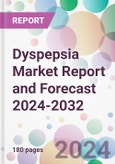Dyspepsia Market Outlook
The dyspepsia market size is anticipated to grow at a CAGR of 8.4% during the forecast period of 2024-2032, driven by the growing emphasis on personalized or precision medicine in disease management across the major markets.Dyspepsia: Introduction
Dyspepsia, commonly known as indigestion, is a condition characterized by chronic or recurrent discomfort in the upper abdomen. Symptoms may include bloating, nausea, belching, and a feeling of fullness or pain after eating. Dyspepsia can result from various causes, including gastritis, peptic ulcers, gastroesophageal reflux disease (GERD), or functional (non-ulcer) dyspepsia, where no clear cause is found. Management typically involves lifestyle modifications, dietary changes, and medications such as antacids, proton pump inhibitors, or H2-receptor antagonists to relieve symptoms.Key Trends in the Dyspepsia Market
There's a growing trend towards increased awareness of dyspepsia symptoms and self-management practices. Over-the-counter (OTC) medications for symptom relief are in high demand, with consumers seeking immediate and accessible remedies.As the understanding of the impact of lifestyle and diet on dyspepsia grows, there's a noticeable shift towards non-pharmacological interventions. This includes dietary modifications, stress reduction techniques, and lifestyle changes as first-line management strategies.
The market is gradually moving towards personalized treatment approaches in managing dyspepsia, especially for cases related to specific underlying conditions like H. pylori infection, GERD, or peptic ulcer disease. This trend is driven by advancements in diagnostic technologies and a better understanding of the pathophysiology of dyspepsia.
There's ongoing research and development of new pharmaceuticals targeting the underlying causes of dyspepsia and improving symptom management. This includes the development of drugs with novel mechanisms of action, such as prokinetics and agents that target the gut-brain axis.
Integration of Digital Health Solutions: Digital health technologies, including apps for diet tracking and stress management, are becoming more integrated into the management of dyspepsia. These tools help patients monitor their symptoms, manage their condition more effectively, and adhere to treatment plans.
Emerging research on the gut microbiome's role in various gastrointestinal disorders, including dyspepsia, is influencing treatment approaches. Probiotics and dietary supplements aimed at restoring gut microbiome balance are gaining popularity as complementary therapies.
Dyspepsia Market Segmentation
Market Breakup by Diagnosis
- Blood Tests
- Stool Tests
- Breath Tests
- Endoscopy
- X-Ray
- CT Scan
- Others
Market Breakup by Type
- Organic Dyspepsia
- Non-Ulcer Dyspepsia
- Drug Induced Dyspepsia
- Others
Market Breakup by Indication
- Functional Dyspepsia
- Organic Dyspepsia
Market Breakup by Treatment
- Proton Pump Inhibitors
- H2 Blockers
- Antacids
- Antibiotics
- Prokinetics
- Antidepressants
Market Breakup by Treatment Type
- Medication
- Surgery
Market Breakup by Drug Type
- Branded
- Generic
Market Breakup by Route of Administration
- Oral
- Injectable
Market Breakup by Region
- United States
- EU-4 and the United Kingdom
- Germany
- France
- Italy
- Spain
- United Kingdom
- Japan
- China
Dyspepsia Market Overview
In North America, the dyspepsia market is driven by a high prevalence of gastrointestinal disorders and a significant focus on digestive health. Lifestyle factors and dietary habits contribute to the demand for treatment options. The market includes a wide range of over-the-counter (OTC) and prescription medications, alongside a growing interest in probiotics and dietary supplements for symptom management. There's also an emphasis on personalized treatment approaches and non-pharmacological interventions, such as dietary modifications and stress management techniques.Europe's market is characterized by strong healthcare systems and an emphasis on evidence-based treatments for dyspepsia. Public health initiatives aimed at improving dietary habits and reducing alcohol and tobacco consumption impact market dynamics. The availability of OTC medications is high, and there's a notable interest in natural and alternative remedies. Regulatory frameworks support rigorous testing and approval processes for new treatments, ensuring patient safety and treatment efficacy.
In Japan, the dyspepsia market reflects the country's high regard for gastrointestinal health, with a wide acceptance of both modern and traditional treatments. Japanese consumers show a strong preference for products with natural ingredients and traditional medicines alongside conventional treatments. The market is supported by advanced healthcare research, leading to the development of innovative therapeutics. Public health campaigns focusing on healthy eating and lifestyle habits also play a crucial role in managing dyspepsia symptoms.
Dyspepsia Market: Competitor Landscape
The key features of the market report include patent analysis, grants analysis, clinical trials analysis, funding and investment analysis, partnerships, and collaborations analysis by the leading key players.- Bayer AG
- Mankind Pharma
- Cadila Pharmaceuticals
- Salix Pharmaceuticals
- Sanofi
- Aosaikand Pharmaceutical Co., Ltd
- Hanmi Pharm. Co.
- Lupin
- RedHill Biopharma Ltd.
- Abbott.
- GlaxoSmithKline
- Johnson&Johnson
- Eisai Co Ltd
- AstraZeneca
- Allergen Plc
This product will be delivered within 5-7 business days.
Table of Contents
1 Preface
3 Dyspepsia Overview
4 Patient Profile
5 Dyspepsia Epidemiology Analysis - 7MM
6 Dyspepsia Market Overview - 7MM
7 Dyspepsia Market Landscape - 7MM
8 Dyspepsia Challenges and Unmet Needs
10 Dyspepsia Market Dynamics
11 Dyspepsia Market Segmentation - 7MM
12 United States Dyspepsia Market
13 EU-4 and United Kingdom Dyspepsia Market
14 Japan Dyspepsia Market
15 Regulatory Framework
16 Patent Analysis
17 Grants Analysis
18 Clinical Trials Analysis
19 Funding and Investment Analysis
20 Partnerships and Collaborations Analysis
21 Supplier Landscape
22 Dyspepsia Market- Distribution Model (Additional Insight)
24 Company Competitiveness Analysis (Additional Insight)
25 Payment Methods (Additional Insight)
Companies Mentioned
- Bayer AG
- Mankind Pharma
- Cadila Pharmaceuticals
- Salix Pharmaceuticals
- Sanofi Aosaikand Pharmaceutical Co. Ltd
- Hanmi Pharm. Co.
- Lupin
- RedHill Biopharma Ltd.
- Abbott.
- GlaxoSmithKline
- Johnson & Johnson
- Eisai Co Ltd
- AstraZeneca
- Allergen Plc







